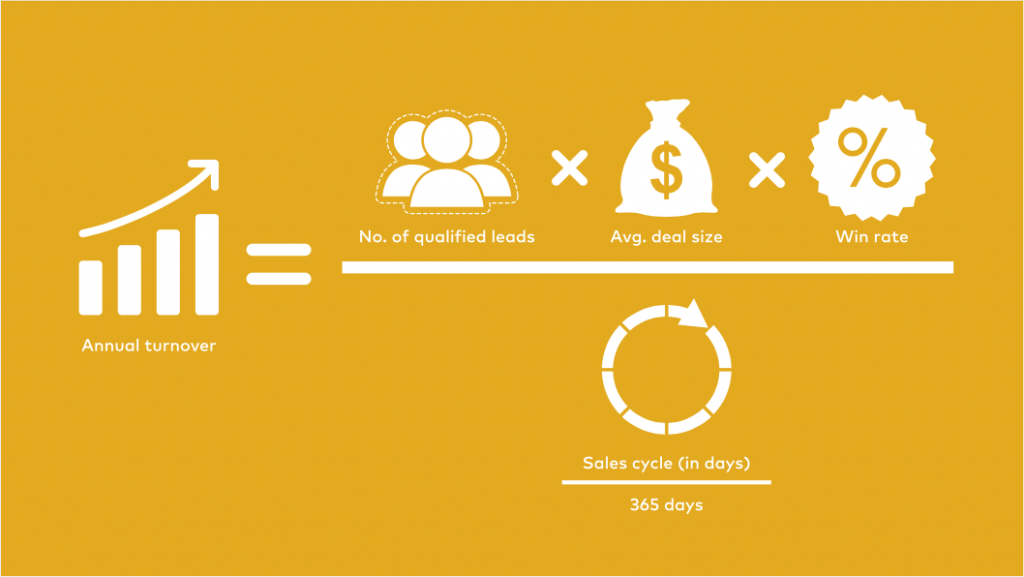In spite of having many years of Sales experience, I was only recently introduced to the Sales Velocity formula when Claus Sejr from Solar showcased it. He shared how they at Solar exploit it to look into growth. I was impressed. The formula is quite simple in itself but offers a lot of value for everyone – small or big – working in Sales.
Briefly described, Sales Velocity is a formula by which several variables can predict Sales for a given period. It measures how fast you are making money by looking at how quickly leads move through your pipeline. The higher the sales velocity, the more revenue you generate in less time.
With a predilection for math and logic, the formula is appealing to folks like me. First and foremost, due to the simplicity of putting Sales in a calculation context, where you, in theory, can underline the result. Next – and most importantly – the formula presents a number of variables that most companies forget to measure. Some very important variables in my opinion.
In this article, I will present a slightly adjusted formula, where the annual turnover becomes the output rather than the turnover generated per day. I do that simply because companies measure turnover on an annual basis and not from day-to-day. In practice, the formula can be used advantageously as a kind of ‘score’ that allows you to benchmark against other Sales teams or departments. But most importantly, the formula can help you optimize the sales process due to its ability to display which variables are lacking behind.
The four variables in the Sales Velocity formula are:
- Number of qualified leads
- Average deal size
- Win-rate
- Sales Cycle (in days) / 365 days
Together, the formula looks as follows:

As demonstrated in the image, the result is the annual turnover.
For example:
You have 50 qualified leads, an average deal size of $80,000, an average win rate of 25%, and a sales cycle of 60 days.
Annual turnover = (50*$80,000*0.25) / (60/365)
= $1,000,000 / (60/365)
= $6,083,333
The annual turnover is thus expected to reach just above 6 Million dollars. This, of course, is a snapshot, and the true value of the formula only becomes apparent when used continuously to highlight the changing variables over time. And that is the whole point; the variables changing over time. Because to achieve a better end-result, you either have to succeed in increasing the numerator and/or decreasing the denominator. So how do you go about that?
- Increase the number of qualified leads: This is most often a task for the marketing department, but in many B2B-companies it’s a mix. How do you get more qualified leads? Is it by utilizing Marketing Automation or by further nurture your network and “must-win” clients?
- Improve the win rate: Do you have a defined and controlled sales process with clearly defined principles for the movement along the pipeline and what actions each step requires? Do you analyze when customers lose interest – is it due to competitors winning them over or is it another “no decision”? Could the sales consultant keep the momentum going by showcasing better sales material or engage with an ROI calculator or demonstrating the cost of not moving ahead now.
- Optimize the average deal size: A way to increase the average deal size is by selling whole solutions rather than individual products. Do you support the sales consultant in the open conversation with the customer, so that the customer discovers the need for products or services they had not realized you offered? Be aware that solution selling probably also will increase the length of the sales cycle, however often also “clue in” the buyer and increase the lifetime value.
- Shorten your sales cycle: If it takes too long to close a sale, you might want to revise the individual steps in your sales process. Where are the bottlenecks? Which steps are taking too long? Could software help you automize or optimize your time?
Hopefully, this introduction has set your thoughts in motion. Instead of always focusing on having enough leads in your pipeline, the formula brings focus to the entire process – and that can really accelerate your growth. If you succeed in improving your win-rate and increase the average deal size it can have a huge impact.
I encourage all Sales directors to engage with the formula and to test it. If it has the potential to work and create value in your team, make sure you gather the sales consultants to conduct a workshop on how the different variables could be optimized. Perhaps once every quarter?
I’m curious; What is your experience? Do you believe that a formula can help create value in Sales?
I have created an interactive calculator with different scenarios for you to play around with. Just click the image below.
Thanks for reading this article. Did you enjoy it? Then you might also find my article Changing Sales from “Solo Silos” to being part of a “Dynamic Team” interesting.
/ Morten Junge



